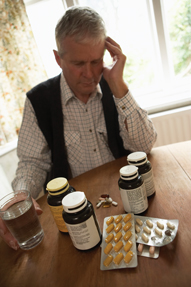New algorithm helps weed out unneeded drugs in the elderly
Geriatrician Doron Garfinkel, MD, developed the Good Palliative-Geriatric Practice algorithm for discontinuing elderly patients' unneeded medications. In a study, he showed how it led to discontinuing 58% of the drugs taken by a group of community-dwelling elderly.
Geriatrician Doron Garfinkel, MD, recently saw a patient who was 90 years old and taking 23 medications, including seven different antihypertensives. “I told his daughter, ‘Probably your father is very strong that he survives this amount of drugs.’”
Most internists would probably agree with Dr. Garfinkel's preference that his elderly patients actually benefit from, rather than just survive, their medication regimens. But Dr. Garfinkel, who is head of geriatrics at Shoham Geriatric Medical Center in Israel, is actually taking action toward this goal.

He has developed the Good Palliative-Geriatric Practice (GP-GP) algorithm for discontinuing elderly patients' unneeded medications. In a study published in the Oct. 11, 2010 Archives of Internal Medicine, Dr. Garfinkel and co-author Derelie Mangin, MBChB, used the algorithm to recommend discontinuing 58% of the drugs taken by a group of community-dwelling elderly (a total of 311 medications for 64 patients). In some cases, patients or their physicians chose to stay on the medications, but in total 256 drugs were discontinued and only six needed to be restarted.
“There is increasing awareness worldwide of the burden of polypharmacy for this aging population. I think there's a lot of thought going into ways in which we address this in a systematic way,” said Dr. Mangin, associate professor at the University of Otago in New Zealand. “What [the algorithm] does is give us a framework in which to do it.”
Step by step
The first step in the GP-GP framework is to look at the evidence for giving a particular drug to an elderly patient. Given the rarity of drug trials in elderly patients, evidence is often lacking. “If the answer is yes, meaning it was proven, continue the drug. But 95% of these drugs in the elderly, the answer is no, meaning we don't have a real evidence base,” said Dr. Garfinkel.
Many preventive medications and supplements, such as statins and calcium, fall into this category and are unproven in frail, seriously ill elderly patients, according to Marcel Arcand, MD, a professor of family medicine at the University of Sherbrooke in Canada. “We sort of extrapolate from a relatively healthy elderly population with few diseases,” he said.
Dr. Garfinkel would like physicians to extrapolate in the opposite direction. When he's teaching, he shows students a painting of a dying patient and asks them a series of questions. “Would you give aspirin to this patient? Statins? How about a week ago? One month before? Six months before?” Estimating life expectancy may make physicians uncomfortable, but it can bring focus to the issue of what drugs are actually needed, Dr. Garfinkel said.
In some cases, changing circumstances may have made medications less useful to a patient, Dr. Mangin said. For example, an older patient who has been on medication when they were younger for high blood pressure may experience lower activity levels, and changes to his or her body mass index.
Dr. Arcand offered additional examples. “A person who walks may have angina, but then when they are bedridden, do they all need two or three types of drugs to prevent angina?” he asked. “Is prevention of osteoporotic fracture as effective in patients who don't walk anymore? The risk of falling is not there anymore.”
However, for patients who are still mobile, the risk of falling may be an argument for discontinuing medications, Dr. Garfinkel noted. He stops benzodiazepines in almost every patient he sees, because of their association with falls.
Obstacles to change
That instruction may sound like a critique of his colleagues, but Dr. Garfinkel doesn't mean it to be. He's well aware of the systemic barriers to implementation of his ideas. “As with most problems that are very hard to solve, there's no one answer or one entity to blame,” he said.
“It's a vicious circle,” explained Dr. Garfinkel. “A patient comes to the hospital, and when he gets out, he's on two or three or four more drugs than on admission. The family doctor says, ‘OK, it was given in the hospital. I won't stop it.’”
Meanwhile, hospitalists and specialists may take a similar approach to medications started by a patient's general internist.
“It's easier to continue the drugs that somebody else started,” Dr. Garfinkel said. “We are taught in medical school when to start drugs. Nobody tells us or teaches if and when to discontinue drugs.”
Discontinuation can also be more time-consuming than starting medications. As it was applied in the study, the GP-GP algorithm starts with an hour-long consultation with the patient and family, something most practicing physicians don't have the time to engage in.
After the consultation, Dr. Garfinkel typically writes patients and their physicians a lengthy letter, which includes a review of the evidence for their medications and his suggestions of medications to discontinue or reduce. (In some cases, he also proposes starting new medications, most often, antidepressants. “Sometimes I'm the first one to note to the family that they're depressed,” he said.)
“It's not just a matter of deciding that the patient is on one too many medications and we're going to cut through them. It's more very thoughtful and very individual consideration of every single medicine that the person's on and whether there can be a trial of stopping or whether the dose can be reduced,” explained Dr. Mangin.
The consideration process should significantly involve the patient, according to the GP-GP authors. “I say, ‘I suggest …’ and I explain why. For some drugs, I say, ‘There is not enough literature to decide. I am inclined to do this,’ but the family will decide,” Dr. Garfinkel said.
Then, if the patient, family and treating physician agree, medications are discontinued simultaneously and then closely monitored for a trial period. If symptoms reappear, the drugs are restarted, but in the published trial, 81% of the drugs recommended for discontinuation were successfully stopped. Overall, 88% of patients reported global improvement in health and, although ten patients died during follow up, no adverse events were found to be attributable to discontinuation.
Future outlook
The results have attracted interest from the medical community, but also trepidation. In response, Dr. Garfinkel offers reassurance as well as caution. “You shouldn't try this at home, as we say, but a physician with clinical judgment can do it.”
Eventually, he'd like to see some physicians specializing in this task, like a case manager for drugs. Preferably, the person would be a geriatrician, possibly working with a pharmacist, who would review all the drugs and talk to the patient, said Dr. Garfinkel.
Dr. Mangin predicts that current trends will push the health care system toward such a model, or at least some action on the issue of elderly polypharmacy.
She said, “The quality of our medical care in the next few decades will be judged more by the wisdom of what we choose not to give than what we do give.”





